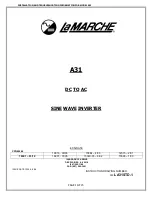
Model 5600MSC Master Clock/SPG Manual
TECHNICAL DESCRIPTIONOPERATION
Revision 1.6
Page
3-53
3.6.12.4. Configuring the AES/DARS Lock Type
OUTPUT
AES/DARS OUTPUT
AES Lock Type
AES lock PAL
AES lock NTSC
The
AES Lock Type
control is used to select how the AES/DARS output will
be aligned to the video. When the dominant output video standard is
NTSC-M or 1.001 HD rates we recommend setting this control to
AES
lo
ck NTSC.
When the dominant output video standard is PAL-B or
1.000 HD rates we recommend setting this control to
AES
lo
ck PAL.
In dual
rate systems, where the frequency reference is GPS, all the video standards
will be phase aligned to the GPS reference and consequently the
AES/DARS frames will also be aligned to both NTSC-M and PAL-B videos
syncs. See recommended practice AES11 for more information on the
preferred relationship between DARS reference and video. See also Figure
3-2 to Figure 3-8.
When this control is set to
AES lock NTSC
, the output AES frames will
maintain their phase relationship with respect to output NTSC-M syncs.
Since it takes 5 NTSC-M frames for an integral number of AES/DARS
frames, this relationship repeats only every 5
th
frame at the start of NTSC
line 4. Any frequency reference input that is a valid source of NTSC-M
output phase (e.g. NTSC-M or 1.001 HD rate genlock inputs or GPS) will
cause a corresponding re-alignment of the AES/DARS outputs to the
NTSC-M phase. Conversely, if the frequency reference input does not
imply any particular NTSC-M output phase (e.g.: 10 MHz or PAL-B inputs),
the AES/DARS output frequency will be synchronized with the input
reference but their phase will remain unchanged. When GPS or NTSC-M
video with a SMPTE 318M 10 field pulse is used as the reference input, the
AES/DARS frames will be aligned to the 10 field input sequence. (See
section 3.6.2.3.11 for a discussion of the 10 field sequence pulses.)
When this control is set to
AES lock PAL
, the output AES frames will
maintain their phase relationship with respect to output PAL-B syncs. Since
every PAL-B frame contains an integral number of AES/DARS frames, this
relationship is defined for every frame at the start of PAL line 1. Any
reference input that is a valid source of PAL-B output phase (e.g. PAL-B or
1.000 HD rate genlock inputs or GPS) will cause a corresponding re-
alignment of the AES/DARS outputs to the PAL-B phase. Conversely, if the
reference input does not imply any particular PAL-B output phase (e.g.: 10
MHz or NTSC-M inputs), the AES/DARS output frequency will be
synchronized with the input reference but their phase will remain
unchanged.
The relationship of AES/DARS to video is defined in AES11-1997
recommended practice.
"
Changing the state of AES Lock Type control will cause momentary disruption in
AES/DARS output signal.
USO
RESTRITO
















































